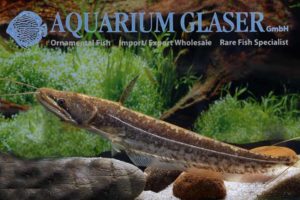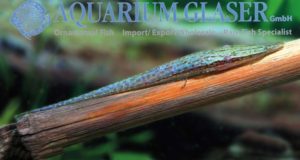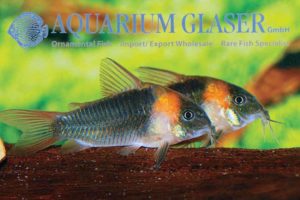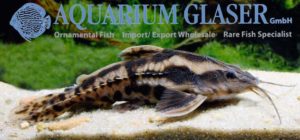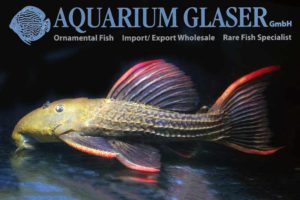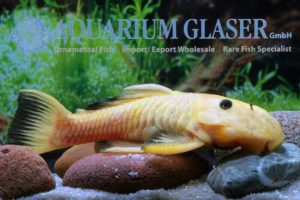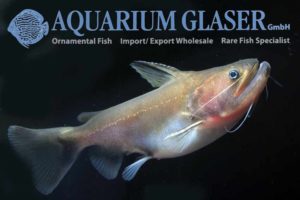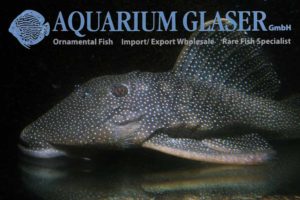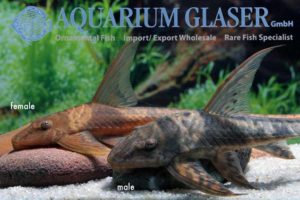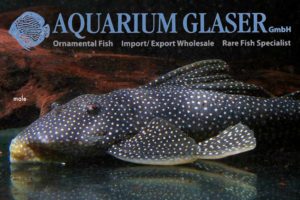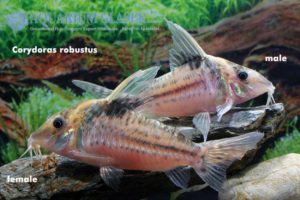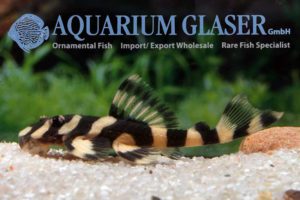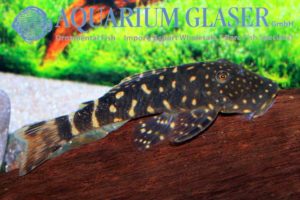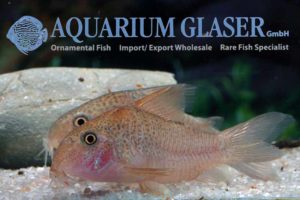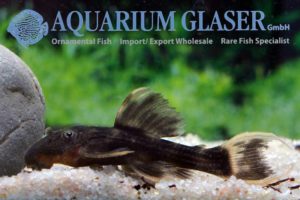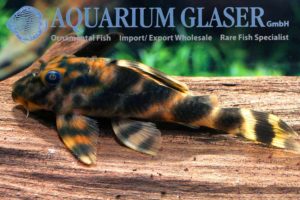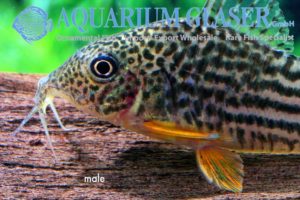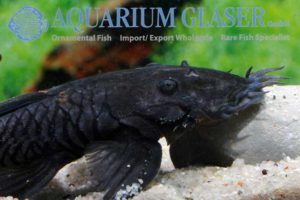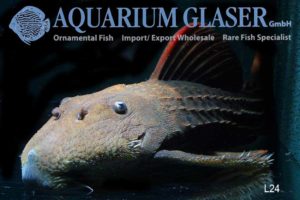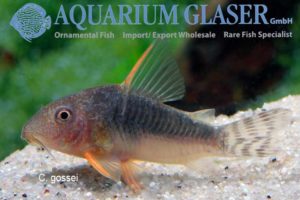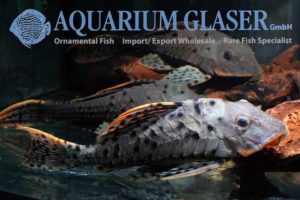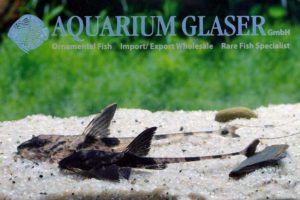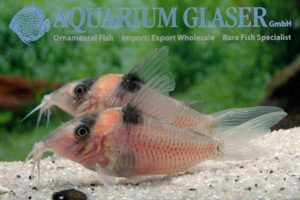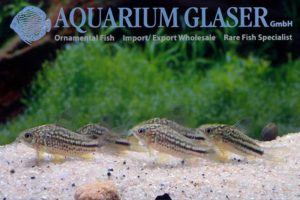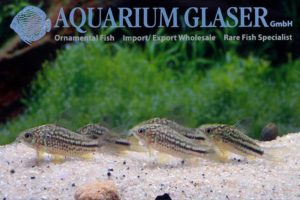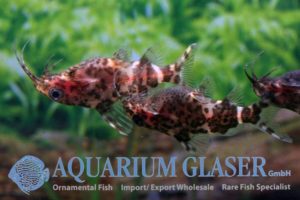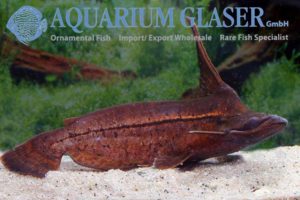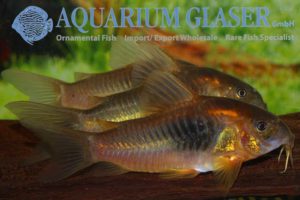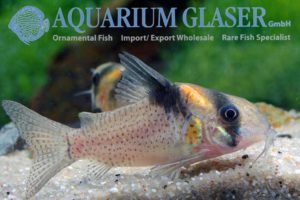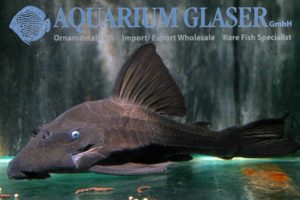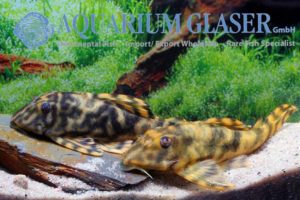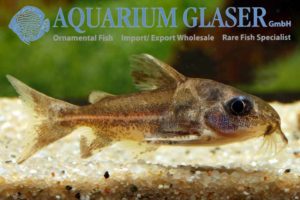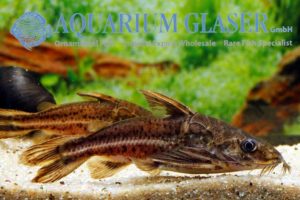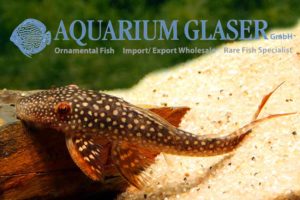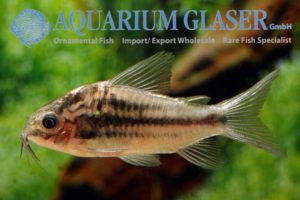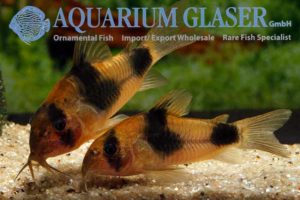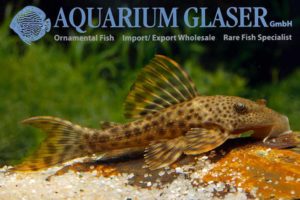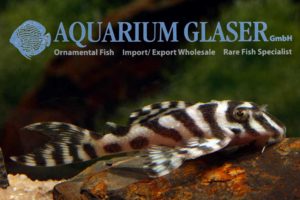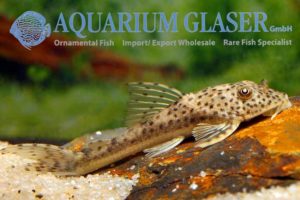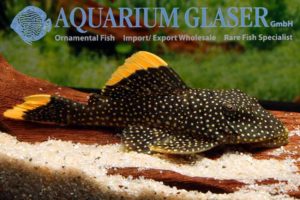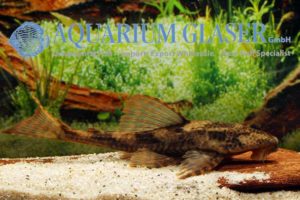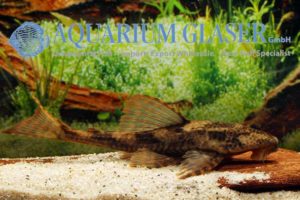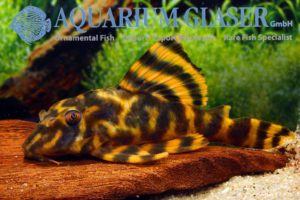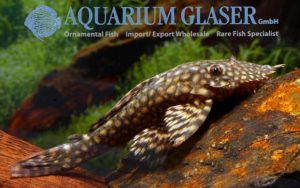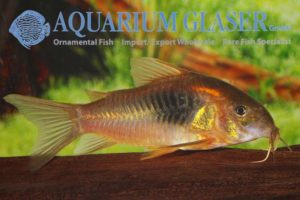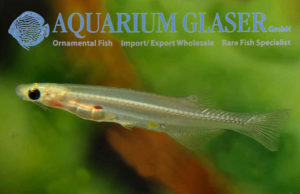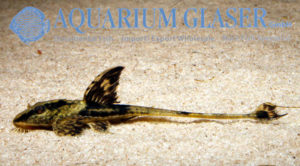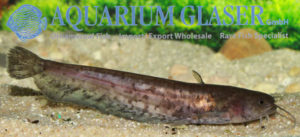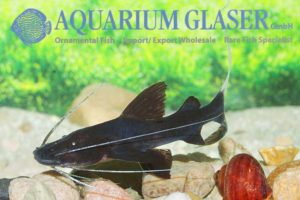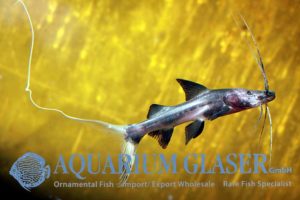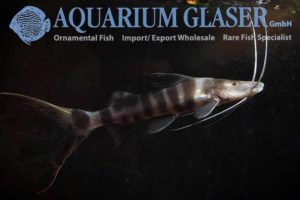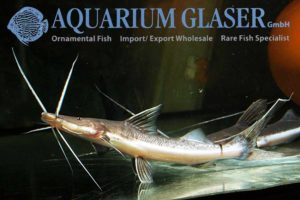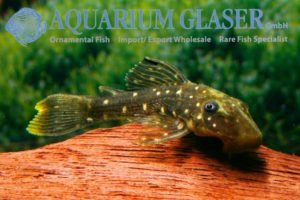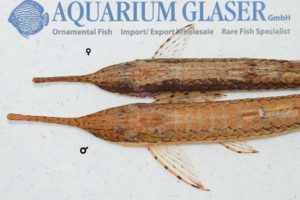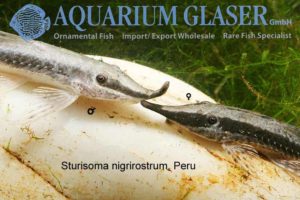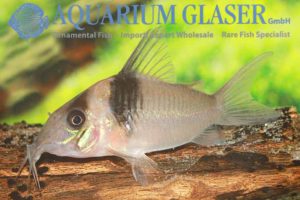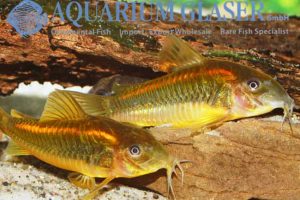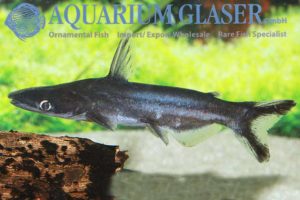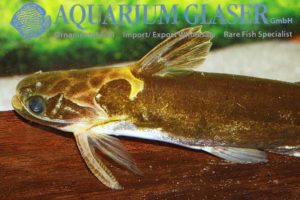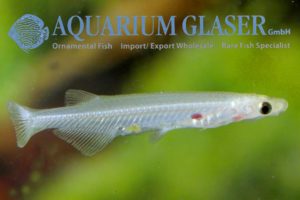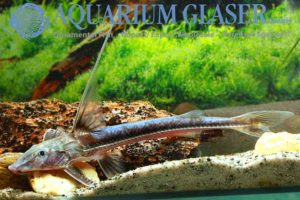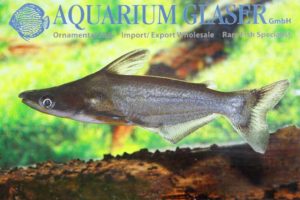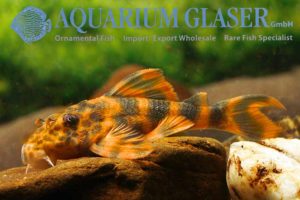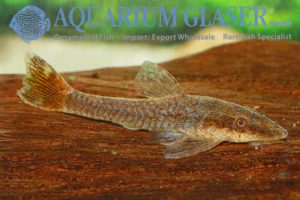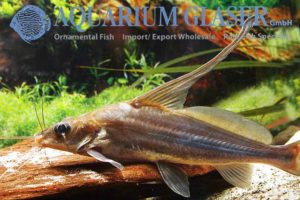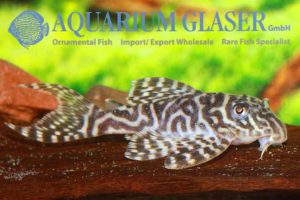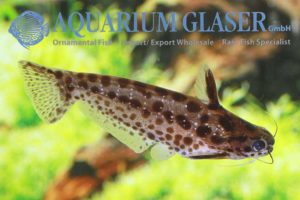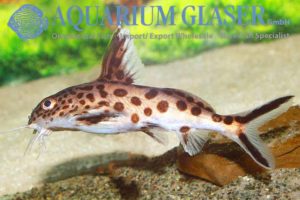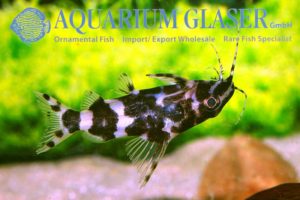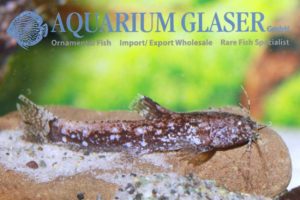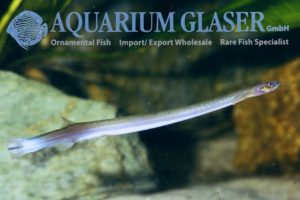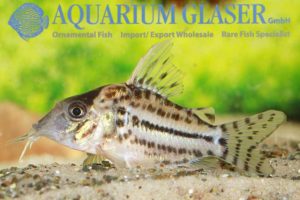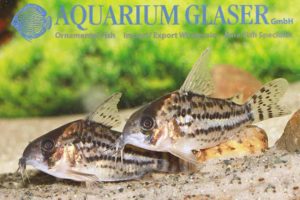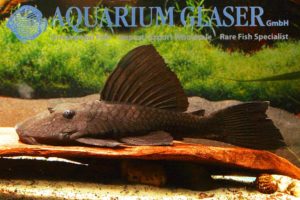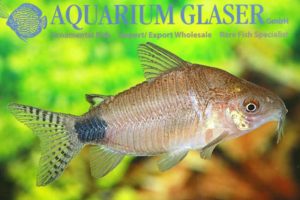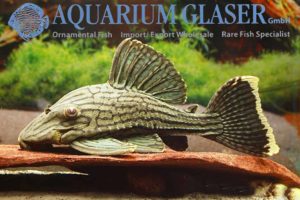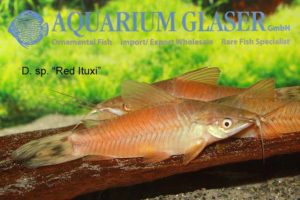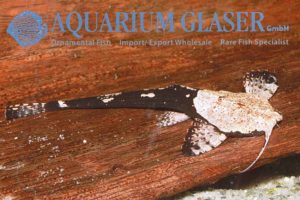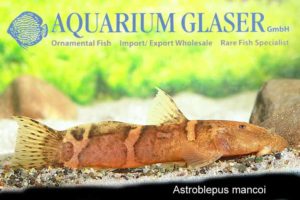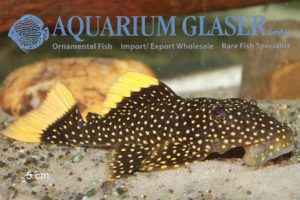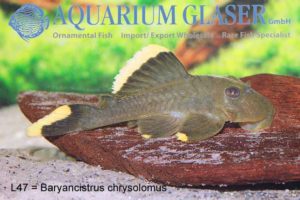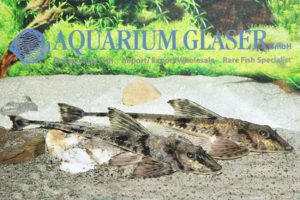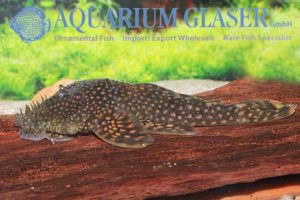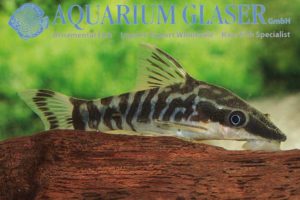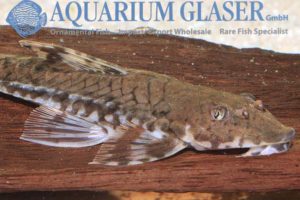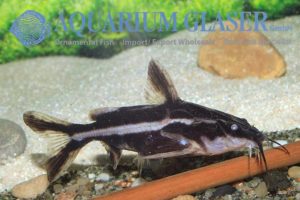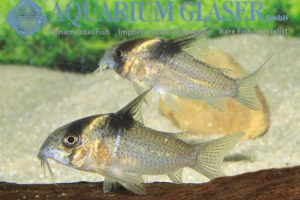We had to try quite long, but finally we succeeded and could import some youngsters of one of the most voracious of all predatory Asian catfishes again. Wallago attu attains a maximum length of about 2 m. The enormous mouth extents far behind the eyes and it contains a large number of spiky teeth. The […]
10. Catfishes (748)
-
-
Acestridium dichromum arrived!
We received the very rare dwarf suckermouth catfish Acestridium dichromum from Venezuela. The species attains a length of 5-6 cm only. The species could be called “chameleon dwarf sucker cat”, for it becomes bright green when sitting on plant leaves, but changes colour to brown within a few days when only roots and stones are […]
-
Corydoras eques
From the Brazilian state of Amazonas we received again a species of Corydoras, which is long known to science but almost unknown in the hobby: Corydoras eques. This unique and extremely colourful species was collected near Anori. This typical schooling Corydoras looks best when it is kept in blackwater. The bright orange band over the […]
-
Megalodoras uranoscopus (= irwini)
Currently we have very nice juveniles of this large species (50-70 cm) of thorny catfish from Peru in stock. For our customers: the fish have code 267503 on our stocklist. Please note that we exclusively supply the wholesale trade. Text & photos: Frank Schäfer
-
A new Cactus Cat related to L24/L25
The Cactus Cats L24 and L25 become around 25-30 cm long and are quite popular among hobbyists with spacy tanks. The fish are very colorful and scientifically still undescribed. L24 originates from the Rio Tocantins and Rio Araguaia, L25 from the Rio Xingu. The two can be best distinguished by the pattern of the head: […]
-
L56x Parancistrus sp. 2-color
We have obtained a small number of this very unusual loricariid from Brazil. “Technically” speaking, they belong to the species P. aurantiacus. The species is famous for the fact that they can be bright golden, marbled or black colored and it is documented that they can change the colours in comparatively short time. This phenomenon […]
-
Asterophysus batrachus
We could import a number of still young, about 5-7 cm long specimens of this unusual catfish from Venezuela. The fish feed readily on feeder fish. Here is the story that belongs to the animals: The Altum-Eater of the Atabapo In the spring of 2004 Aquarium Glaser managed to import for the first time one […]
-
Baryancistrus xanthellus (L18) adult
The Yellow Seam Plecos or Golden Nuggets of the genus Baryancistrus (L18, L81, L177, see http://www.aquariumglaser.de/en/fish-archive/l-numbers-en/_en-2/ for an overview) belong to the most desirable species of pleco at all. Young fish look very beautiful. However, almost exclusively young specimens are available in the trade. Thus we were very glad that we were able to manage […]
-
Lamontichthys llanero
Currently we have this beautiful, but only very rarely available catfish in different sizes in stock. For more information on the species please see http://www.aquariumglaser.de/en/fish-archive/catfish-en/loricariidae-en/Lamontichthys_llanero_en/http://www.aquariumglaser.de/fischarchiv/welse/loricariidae/Lamontichthys_llanero_de/ For our customers: the fish have code 264854 (5-8 cm) and 264856 (10-12 cm) on our stocklist. Please note that we exclusively supply the wholesale trade. Text & photos: Frank […]
-
Scobinancistrus sp. L253
This beautiful loricariid originates from the Rio Xingu. It becomes collected upstream from Altamira. In all probability the species can attain a maximum length of about 35 cm, but there are no reliable information on that topic available. The pretty pair we have currently in stock (and which made a good job as photo model) […]
-
Show Corydoras arrived!
We received two very rare species of Corydoras from Brazil, which represent moreover two of the largest species of Corydoras at all: the “real” Corydoras narcissus (I), which can attain a maximum length of almost 10 cm, and Corydoras robustus, which can become even one centimeter longer. For the differences beween C. narcissus I and […]
-
L168 bred specimens
Once more we received very pretty bred L168 from our proofed breeder. Currently the fish are 4-5 cm long. The scientific name of the species is Zonancistrus brachyurus. The wrong name “Peckoltia pulcher”, however, still often appears on the stocklists. For our customers: the animals have code 26480-L168x-1 on our stocklist. Please note that we […]
-
L455 Chaetostoma sp. Tiger
Finally we were able once more to import the wonderful Chaetostoma sp. Tiger from Peru. This is our second importation since 2011. Due to the fact that we offered the first specimens long before they attained a L-number they formerly had the codenumber 214844 on our stocklist. Now they have 26480-L 455-4 (5-7 cm) and […]
-
Corydoras polystictus
We received from Brazil the very rarely offered, beautiful Corydoras polystictus. C. polystictus inhabits the Rio Paraguay basin in Brazil, Paraguay, and Argentina. Corydoras polystictus is a deep bodies species, which likes to swim along with conspecifics. The spotted pattern varies in each individual. Maximum size reported for the species is around 4.5 cm. For […]
-
L25 Pseudacanthicus sp. Scarlet: German bred babies!
L25 “Scarlet” is still one of the most sought after large loricariids. Now we can offer for the first time ever German bred specimens of this beautiful species which are currently 4-5 cm long. For our customers: the animals have code 26480-L 25X-0 on our stocklist. Please note that we exclusively supply the wholesale trade. […]
-
Peckoltia sp. L202
We received very nice coloured L202 from Colombia. This species of Peckoltia has the additional L-numbers LDA 57 and LDA 79. The fish attains a maximum length of 12-14 cm. They should be kept at temperatures of about 25-29°C. For our customers: the animals have code 26480-L 202-2 on our stocklist. Please note that we […]
-
Corydoras haraldschulzi
Finally this beautiful cory, the long snouted counterpart to C. sterbai, is available again – in show size! For our customers: the fish have code 231505 on our stocklist. Available in limited numbers only! Please note that we exclusively supply the wholesale trade. Text & photos: Frank Schäfer
-
L34 Ancistrus ranunculus
Once more we were able to import one of the flattest species of L-numbers: Ancistrus ranunculus (L34). In any case it is the most emancipated of all, because in this species also the females wear a pretty large beard! For our customers: the animals have code 26480-L 034-3 on our stocklist. Please note that we […]
-
Huge range of large Pseudacanthicus in stock!
Currently we can offer several species of the magnificent Pseudacanthicus in show size: L24, Pseudacanthicus serratus, 30-35 cm, only one specimen available, code 26480-L 024-8 on our stocklist L25, Pseudacanthicus sp. Scarlet, 30-35 cm, only one specimen available in that size, code 26480-L 025-8 L25a, Pseudacanthicus sp. Sao Felix, 30-35 cm, also only one specimen […]
-
Corydoras gossei and Corydoras seussi WILD
Finally we were able to import once more the wonderful cory Corydoras seussi and its very rare, longsnouted sister species C. seussi. For our customers: the fish have code 230253 (C. gossei) and 230263 (C. seussi) on our stocklist. Please note that we exclusively supply the wholesale trade. Text & Photos: Frank Schäfer
-
Pseudorinelepis sp. L 95
Once more we were able to import another catfish gem: L95, a scientifically undescribed species of the genus Pseudorinelepis, which is very closely related to P. genibarbis. Our specimens come from the Takutu river in the upper Rio Branco basin. These gorgeous fishes are collected mostly in relative large specimens, because the juveniles are not […]
-
Loricaria simillima bred
We received charming German bred specimens of this mouthbreeding whiptail catfish. Just like the parents the offspring shows a great variability regarding coloration. For our customers: the animals have code 266651 on our stocklist. Please note that we exclusively supply the wholesale trade. Available in limited numbers only! Text & photo: Frank Schäfer
-
Corydoras amandajanea
This beautiful species of Corydoras is only occasionally available. It has a comparably pointed snout and becomes around 6 cm long. In its natural habitat this species lives in dark water. So it has only very few markings on the light colored body: the dark eyeband and a rectangular blotch right below the dorsal fin. […]
-
Corydoras sp. San Juan
The corys belonging to the Corydoras-elegans-complex are very variable in respect of coloration. Moreover they have a juvenile coloration that differs from the adult coloration, and the males have another coloration than the females. This makes them really difficult to apply to a described species. But the fish are very beautiful! Currently we have one […]
-
Corydoras sp. San Juan
We received again this pretty and very variably colored Cory from Peru. It remains still an open question whether “San Juan” belongs to Corydoras napoensis, C. bilineatus or an undescribed species. The Corydoras-elegans-group, to which “San Juan” belongs without any doubt, is in need of revision. May this be as it is: “San Juan” is […]
-
Synodontis nigriventris – finally available again!
This species represents without any doubt the most popular African catfish at all. The Upside Down Cat (Synodontis nigriventris) has reached us in good numbers and a perfect size again. Currently the fish are 3-4 cm long. For our customers: the fish have code 183402 on our stocklist. Please note that we exclusively supply the […]
-
Tetranematichthys wallacei
Currently three different species of the remarkable genus Tetranematichthys are distinguished by scientists. None of them is often imported, because their secretive way of life between dead driftwood makes catching them a pure matter of luck. So we are very glad to have managed the first imporation ever of the species Tetranematichthys wallacei from Venezuela. […]
-
Corydoras aeneus “Puerto Maldonado”
We received this beautiful colour morph of the Bronze corydoras that exhibits a lot of orange colours from Peru. It belongs to the “Gold Shoulder” group, which is sometimes named Corydoras schultzei; however, this name is currently considered to be a synonym of C. aeneus. The fish is very rare and available in limited numbers […]
-
Corydoras cf. kanei C142
C142 is a very beautiful, peaceful and comparatively small species of Corydoras: it becomes around 5 cm long. It is said that C142 originates from the Rio Tapajos. Corydoras kanei is quite similar to C142, but the latter is distinguished from the former by the bright golden spots on the neck and the operculum. Such […]
-
Panque suttoni
The Blue-eyed Panaque was in the 1980ies one of the most common loricariids in the trade. By the way: the correct scientific name is Panaque suttonorum. For unknown reasons the fish is hardly available nowadays. There are, however, a lot of rumours. Some say that an ecological catastrophe appeared, others tell that a madman has […]
-
Peckoltia sp. Alto Nhamunda
For the first time ever we could import this attractive dwarf suckermouth catfish. The maximum length observed was about 14 cm. The males – they can be easily recognized by the long “whiskers” – have a very obvious different colour compared with the females. For our customers: the animals have code 277334 on our stocklist. […]
-
Acestridium dichromum arrived!
We received once more the very rare dwarf suckermouth catfish Acestridium dichromum from Venezuela. The species attains a length of 5-6 cm only. The species could be called “chameleon dwarf sucker cat”, for it becomes bright green when sitting on plant leaves, but changes colour to brown within a few days when only roots and […]
-
Trachydoras paraguayensis
We have received one more charming species of thorny catfish from Paraguay. T. paraguayensis becomes around 10 cm long and can be kept in the same way as a larger species of Corydoras. This means: a peaceful fish, undemanding regarding food and likes to swim in company of its own kind. For our customers: the […]
-
Ossancora punctata
Despite the facts that this pretty thorny catfish, which we were able to import once more from Paraguay, is known to science since 1855 and has an enormous wide distribution in South America – it is reported from Argentina, Brazil, Bolivia, Colombia, and Peru, where it is found both in white and black water – […]
-
Lasiancistrus heteracanthus
We were able to import the rare Red-eyed Deltatail-suckercat, Lasiancistrus heteracanthus, in small numbers from Peru. The species attains a total length of 15-18 cm. Besides the bright red eye the most striking feature of the species is the pretty brown-red lower lappet of the caudal fin. Lasiancistrus, in general, are good algae-eaters and fit […]
-
Corydoras sp. aff. elegans C 126
This is a further new species of Corydoras from the Madre de Dios region. The species attains a maximum length of about 4-5 cm. Males and females look very different. Whereas the males have a coloration similar to that of C. elegans, the females imitate the C. aeneus “Madre de Dios”. In contrast to many […]
-
Corydoras weitzmani WILD
We received a shipment of beautiful, fully grown wild collected Corydoras weitzmani from Peru. The species is extremely rare in the trade. Our fish have a perfect condition! There were strong doubts not long ago that the species might not exist at all or that it has been extinct. This was due to the fact […]
-
Hypostomus sp. Bolivia Redfin
In the Mergus Welsatlas, Vol.2, page 1110 the authors H.-G. Evers and I. Seidel illustrate a pretty Hypostomus originating from Bolivia. The determination of the species was not possible yet. The species reminds one strongly of L231 from Peru, but the new pleco from Bolivia has nice orange-reddish seams in the fins. We currently received […]
-
Hypancistrus sp. L236 bred
Zebra plecos from the Rio Xingu and its affluents are banned for exportation for years already. Even at the times when a legal exportation was possible, L236 from the Rio Iriri (an affluent of the Xingu) was extremely rare and only few specimens were caught per year. The specimens we currently have in stock are […]
-
Aphanotorulus frankei Bolivia
The genus Aphanotorulus contains only two species, following some scientists: A. ammophilus from the Orinoco basin and A. unicolor from the complete upper Amazon basin. However, aquarists are by far more splitting in this respect and distinguish at least four different species, among them A. frankei from Peru. We now received a shipment Aphanotorulus from […]
-
A new Golden Nugget
The Golden Nuggets (L18, L81, L81n, L177) belong to the genus Baryancistrus and have been described scientifically under the name of B. xanthellus. However, it is still unclear wether all these forms belong to the very same species or if they represent close relatives, but seperate species. For the differences, please see http://www.aquariumglaser.de/en/baryancistrus-l18,-l81,-l81n,-l177_de_1072.html Now we […]
-
Hypostomus ancistroides
Once more we were able to import this extraordinary slender, very rare Hypostomus from Paraguay. The subtropical species tolerates temperatures between 16 and 28°C and attains a maximum length of about 20-25 cm. For our customers: the fish have code 262454 on our stocklist. Please note that we exclusively supply the wholesale trade. Available in […]
-
Hypostomus ancistroides
This extraordinary, very slender species reached us from Paraguay. Maximum length reported is around 25 cm. This is a subtropical species and thus it is possible to keep it in an unheated indoor-tank. This is a very rare species and even we are able to offer it only very frequently and in limited numbers. For […]
-
Corydoras aeneus Puerto Maldonado
We received this beautiful colour morph of the Bronze corydoras that exhibits a lot of orange colours from Peru. It belongs to the “Gold Shoulder” group, which is sometimes named Corydoras schultzei; however, this name is currently considered to be a synonym of C. aeneus. The fish is very rare and available in limited numbers […]
-
Peckoltia sp. Red Tiger
For the fitrst time ever we could import this extremely attractive Peckoltia from Brazil. The animals are 10-12 cm long and obviously sexually mature already. Available in very limited numbers only! For our customers: the fish have code 277313 on our stocklist. Please note that we exclusively supply the wholesale trade. Text & photos: Frank […]
-
Ancistrus sp. L89 wild
We received wild collected specimens of one of the most sought-after for species of Ancistrus from Brazil: the pretty L89 from the Purus. In L89 the nice “honeycomb-decor” stays life-long, whereas in most other similar species of Ancistrus this pattern becomes more and more dark during life. Available in limited numbers only! For our customers: […]
-
Corydoras aeneus “Puerto Maldonado”
We received this beautiful colour morph of the Bronze corydoras that exhibits a lot of orange colours from Peru. It belongs to the “Gold Shoulder” group, which is sometimes named Corydoras schultzei; however, this name is currently considered to be a synonym of C. aeneus. The fish is very rare and available in limited numbers […]
-
Tridensimilis brevis
Once more we were able to import this charming, tiny, free-swimming dwarf catfish (maximum length: 2-3 cm). This time the fish originate from Paraguay. For more information, please see http://www.aquariumglaser.de/en/news/Tridensimilis_brevis_en/ For our customers: the fish have code 298152 on our stocklist. Please note that we exclusively supply the wholesale trade. Text & photo: Frank Schäfer
-
Loricaria sp. Colombia BRED
For the first time ever we received German bred specimens of this attractive, mouthbrooding whiptail cat. The species is still undescribed scientifically, attains a maximum length of about 20 cm and is characterized by its unique harness stripes. For our customers: the fish have code 266621 on our stocklist. Please note that we exclusively supply […]
-
Silurus glanis
The Wels catfish or Sheatfish (Silurus glanis) lived initially in eastern Europe and central Asia, but was spread as a food fish over large regions by humans. The species belongs to the largest species of freshwater fish known so far. Current records mention up to 3 m long fish that are as heavy as 150 […]
-
Brachyplatystoma juruense
We have received once more this rare ctafish from Peru. In the meantime the specimens are perfectly acclimatised. More informations on the fish are available on http://www.aquariumglaser.de/en/news/Brachyplatystoma_juruense_en/ Available in limited numbers only! For our customers: the fish have code 211200 (5-8 cm) on our stocklist. Please note that we exclusively supply the wholesale trade. Text […]
-
Brachyplatystoma juruense
From Peru we received once more juveniles of the fantastic predatory catfish B. juruense. Adults of this species attain a maximum length of around 60 cm and have a very nice, zebra-like striped pattern. The coloration of the body of the juveniles is very variable. There do exist spotted ones, striped ones or even uniformly […]
-
Brachyplatystoma juruense
This species of catfish is a predator and becomes easily longer than 60 cm. So it is suited only for specialized aquarists and public aquaria. Our current importation from Peru contains one specimen that is even as a youngster very attractive colored.
-
Brachyplatystoma platynemum (= Goslinia platynema)
We received some specimens of this extremely rare catfish from Peru. The animals are in perfect condition and currently 14 – 16 cm long. For our customers: the fish have code 254783 on our stocklist. Please note that we exclusively supply the wholesale trade. Text & photos: Frank Schäfer
-
Hypostomus luteus – bred ones available!!!
We are currently in the lucky position to be able to offer the only existing bred specimens of this gorgeous sucker cat from the south of South America. The specimens have a size of 3-4 cm. We enclose some pics of adults we imported in 2009 from Agentina to give a reminder what will become […]
-
Farlowella oxyrrhyncha
For the first time ever we received this extreme sharp nosed needle sucker in very limited numbers from Peru. For our customers: the fish have code 253864 on our stocklist. Please note that we exclusively supply the wholesale trade. Text & photos: Frank Schäfer
-
Sturisoma arrived!
We received gorgeous, large Sturisoma robustum from Paraguay and the quirky S. nigrirostrum from Peru. In the Peruvian Whiptail S. nigrirostrum the male developes an upturned “nose”. The sense of this feature is unknown. For more information on S. robustum, please click http://www.aquariumglaser.de/en/fish-archive/catfish-en/loricariidae-en/_en-3/. For our customers: Sturisoma robustum has codes 294874 (12-15 cm) and 294875 […]
-
Farlowella platorhynchus
The needle suckers (Farlowella) belong to the most specialized Loricariids at all. Their whole life is dedicated to the trick to look like a stick. Currently we received fantastic, up to 18 cm long Farlowella platorhynchus from Peru. There is a lot of variation observable regarding coloration. Males and females can be distinguished best by […]
-
Corydoras virginiae
Currently we have one of the most attractive species of Corydoras from Peru in stock. This species caused – along with some other species – the Corydoras boom that started more than 15 years ago. At this time C. viriginiae was still undescribed was called “C4”. This Corydoras is a schooling fish. Moreover it is […]
-
Corydoras sp. Neon Red Stripe
Currently we have a top rarity in stock: the extremely rarely imported Corydoras sp. Neon Red Stripe! Until now we could offer only bred ones from time to time. These beautiful, wild collected fish are available only in very limited numbers! For our customers: the fish have code 221033 on our stocklist. Please note that […]
-
Ageneiosus sp. III GREEN STRIPE
We received a very limited number of this dolphin cat from Peru. The species may reach about 20 cm in total length, currently the fish are 7-10 cm long. For our customers: the animals have code 203264 on our stocklist. Please note that we exclusively supply the wholesale trade. Text & photos: Frank Schäfer
-
Tatia sp. Tahuayo River
We received this pretty new species currently from Peru in small numbers. The Tahuayo river, a tributary of the Amazon river, was given as collecting site. Our specimens are 10-12 cm long. They cannot be assigned for sure to any known species. Obviously it is a close relative of Tatia nigra from the central Amazon […]
-
Tridensimilis brevis
Currently we received the cute freeswimming dwarf glass cat Tridensimilis brevis from Peru. The fish attains a maximum length of 3 cm. It belongs to the notorious candiru relationship, but is no blood sucker at all. This tiny catfish is that translucent that it is possible to observe the way of the food from the […]
-
Leptodoras juruensis
Once more we were able to import the very rare, bizarre Leptodoras juruensis from Peru in a very limited quantity. For our customers: the fish has code 266065 on our stocklist. Please note that we exclusively supply the wholesale trade.
-
Ageneiosus cf. atronasus
For the first time ever we received now this interesting doplhin catfish from Peru. In contrast to many of its congeneers this species stays relatively small and reaches only 12 cm in total length. Thus it is suitable also for normal sized home aquaria. However, one should always keep in mind that these catfishes are […]
-
Ancistomus sp. L387 “Orange” – young adults in stock
The wonderful L387 is only very occasionally available. Currently we have young adults of 5-7 cm length in stock (females are smaller than the males). Our animals are German bred ones. For more information, please check http://www.aquariumglaser.de/en/ancistomus-sp-l387—beautiful-bred-ones-available_en_1284.html Text & photos: Frank Schäfer
-
Hisonotus nigricauda
For the first time ever we were able to import this charming dwarf catfish from Paraguay. The species looks quite similar to the well known “Otocinclus Negros” (the correct specific name of that fish is Otothyopsis piribebuy) and can be kept the same way. The most obvious difference between the two species is the coloration […]
-
Mystus bocourti
Due to its extremely prolonged dorsal fin this fascinating species has also been placed in a genus on its own for a long time, namely Heterobagrus. The catfish becomes around 20-25 cm long. It is a very peaceful species; however, fish of small size will be taken as food, but neither congeneers nor any other […]
-
Hypancistrus sp. L400
Code 26480-L400x-2
-
Trachelyichthys sp. Jutai
We currently received this cute driftwood catfish from Brazil. Initially we thought all fish of the import would belong to the same, highly variable coloured species; but in the meantime we found that in fact two species were involved, namely T. sp. “Jutai” and Auchenipterichthys punctatus. Most probably Trachelyichthys sp. “Jutai” becomes as big as […]
-
Synodontis multipunctatus
Code: 183003
-
Synodontis sp. aff. nigriventris ZEBRA
We currently have a limited number of the very pretty and rare Synodontis sp. aff. nigriventris ZEBRA in stock. The species differs from the “common” Upside Down Catfish by the extremely contrasting pattern. The species is – as far as it is known – restricted to the Mai Ndome region in the DR Congo. Size […]
-
Parakysis verrucosus
For the first time ever we received this tiny and charming dwarf fish from Malaysia. It reaches only 3-4 cm in length. The species is adopted to black water habitats in nature, where the water is very soft and acidic. However, in our facility they have proofed so far to be unproblematic and quite gregarious. […]
-
Plectrochilus erythrurus
We managed to import a few specimens of the exteme rarely imported, blood sucking Candiru-catfish species Plectrochilus erythrurus, which have currently a length of 12-15 cm, from Peru. For our customers: the fish have code 280754 on our stocklist. Please note that we exclusively supply the wholesale trade. Text & photos: Frank Schäfer
-
Corydoras sp. C141
One could term this beautiful cory also the long-nose schwartzi. Obviously the species has not been described scientifically yet. It is not known from which river the fish originates. Sometime C141 is confused with C. ornatus, but the latter has never a cream-white dorsal spine. C141 attains a length of about 6 cm. Code: 241724 […]
-
Corydoras schwartzi
This good old fashioned, but still very beautiful cory originates from the system of the Rio Purus in Brazil. In contrast to the other species mentioned here the dorsal spine is only occasionally cream-white. The species belongs to the group of stout Corydoras with round noses. It can be quite easily recognized by the black […]
-
L261a – Ancistrinae gen. sp.
This species of fish is among the rarest of all L-numbers. It belongs not only to none of the species described so far, but also cannot be applied to any described genus. L261 was imported initially from the Orinoco in Venezuela. The individual we were able to import now for sure belongs to the same […]
-
Corydoras guapore
Sadly this charming cory is only occassionally available. We recieved once more a small number of the fish. For our customers: the species has code 230504 on our stocklist. Please note that we exclusively supply the wholesale trade. Photo: Frank Schäfer
-
Panaque sp. L418 Shampupa
The magnificent Panaque species which belong to the P.-nigrolineatus-complex are much sought for ornamental fishes. All species seem to become around 40 cm long. One of the most spectacular ones originates from Peru and received the L-number 418. Characteristic features of the fish, which is called Shampupa by the exporters, is the broad light band […]
-
Dianema sp.
The genus Dianema comprises currently only two valid species (D. longibarbis and D. urostriata), which are pretty easy to distinguish due to the very different coloration of the caudal fin. From Brazil we now received a third species under the name of “RED ITUXI”. Obviously the collectors in the field observed that the basic colour […]
-
Pterobunocephalus depressus
This is by far the most attractive species of all banjo cats – and the rarest. We recently received the fish for the first time from Peru. It is also one of the most variably coloured species of banjo cat. Most specimens have a sharp black-and-white contrasting pattern, being white anterior and black posterior. But […]
-
Astroblepus from Peru imported!
The L-numbers or Loricariidae belong to the most popular species of catfish from South America. But even very experienced aquarists will hardly ever had the opportunity to see alive a specimen of the genus Astroblepus, although the family Astroblepidae, which includes the single genus Astroblepus, is the closest relative of the loricariids. Astroblepids are distinguished […]
-
Baryancistrus sp. L81n
We take the opportunity of the receipt of a larger shipment of L81n and the scientific description of Baryancistrus xanthellus (L18, L81, L85, L177, see http://www.aquariumglaser.de/en/news/l18_l81_l85_l177_and_l47_described_scientifically_en/) to take a closer look on L81n, which we get from Sao Felix do Xingu, once more. As in all ancistine catfish it is also true in L81n: the […]
-
L18, L81, L85, L177, and L47 described scientifically
These plecos, which originate from the Rio Xingu and its tributary Rio Iriri belong to the most popular L-numbers. Now they have been described scientifically. L18, L81, L85, and L177 belong to the same species (although L81 has not been mentioned in the paper) and have been named Baryancistrus xanthellus, whereas L47 has been named […]
-
Loricaria simillima from Paraguay arrived
Beautiful wild collected specimens of this mouthbrooding whiptail cat arrived right now from Paraguay. Read more about this fish here: http://www.aquariumglaser.de/en/fish-archive/catfish-en/loricariidae-en/Loricaria_simillima_en/
-
Ancistrus sp. L309
Finally we were able once more to import this very nice and unique member of the specious genus Ancistrus: L309. The species has not been described scientifically yet and originates from the Rio Tapajós. The fish is so different from the other members of the genus that is was even thought at times that it […]
-
Otocinclus cocama
The dwarfish catfishes of the genus Otocinclus are usually kept due to their algae-eating activities and their nice behaviour. The coloration of most of the species is only rather dull. Otocinclus are very famous for cleaning especially the waterplants without hurting them. Could it be that there exists a species that is not only very […]
-
Hemiloricaria castroi
It was in August of the past year (2010) that we posted a notice on the successful importation of a wild collected lutiono of Hemiloricaria from Peru (http://www.aquariumglaser.de/en/hemiloricaria-sp-golden-lutino_de_1209.html). The animal is still living in our facility (May 2011) and has changed its coloration completely as can be seen on the new photos. Moreover, now it […]
-
Orinocodoras eigenmanni
The talking catfishes (Doradidae) are an interesting group of fishes in many ways. A lot of the species have a very contrasting pattern of dark and light elements, they can make sounds (that can be compared with a grumbling or gnarling) and their armour of bony plates often looks that bizarr that one might think […]
-
Corydoras cf. bicolor
This beautiful new Cory reached us from Brazil. The black- and-white pattern looks like in C. brevirostris whereas the bright orange-yellow mark on the back (right in front of the dorsal fin) looks like in the very similar species C. bicolor. However, both species do not appear in Brazil as far as it is known. […]
Three rare catfish-species from Paraguay
We received three very rare and interesting species of catfish from Paraguay:

The pretty cory Corydoras diphyes, the dwarf sucker Otocinclus mimulus that lives along with C. diphyes and imitates that species, and the charming dwarf sucker Hisonotus nigricauda. We already have pages on our site, so please follow the links given here:

Corydoras diphyes: http://www.aquariumglaser.de/en/fish-archive/corydoras-en/Corydoras_diphyes_en/


Otocinclus mimulus: http://www.aquariumglaser.de/en/news/otocinclus_mimulus_en/

Hisonotus nigricauda: http://www.aquariumglaser.de/en/fish-archive/catfish-en/loricariidae-en/Hisonotus_nigricauda_en/


For our customers: the animals have code 227563 (Corydoras diphyes, lg-xlg), 273994 (Corydoras mimulus, xlg), and 258433 (Hisonotus nigricauda, lg) on our stocklist. Please note that we exclusively supply the wholesale trade. The photos show animals from our current stock.
Text & photos: Frank Schäfer
Once more: four Corydoras from Peru
We want to prolong our small news series on wild collected Corydoras from Peru once more; we simply have so many beautiful species in stock! And here we go:

Corydoras cf. sychri C97
Magnificent, large animals, available only very occasionally and in small numbers. Code 247024 on our stocklist.

Corydoras leucomelas
An ideal cory for smaller community tanks; this species attains a maximum length of 4 cm only. Code 233503 (md) and 233504 (md-lg).

Corydoras arcuatus
A real classic and simply beautiful. We have two sizes in stock, among them some xlg-animals (photo). Code 222003 (md) and 222005 (xlg).

Corydoras sp. C91
This fish is scientifically still undescribed and a real rarity. Very attractive! Code 229603
Please note that we exclusively supply the wholesale trade.
Text & photos: Frank Schäfer
Further species of Corydoras from Peru
Our last newsletter presented to you some Corydoras from Peru we currently have in stock. However, there are many more attractive species of that genus in Peru. Here are another four of them that can be currently recommended.


Corydoras reticulatus – a very beautiful, deep-bodied cory with golden-green shine. Code 243504 on our stocklist.


Corydoras leopardus xl – the long-snouted species, counterpart of Corydoars julii and C. trilineatus. Very nice fish! Code 233405


Corydoras rabauti – this pretty species has been named in honour for the discoverer of the neon tetra, A. Rabaut. Code 243004


Corydoras virginae (C4) – an extraordinary species with an extraordinary pattern, very attractive! Code 240604
Please note that we exclusively supply the wholesale trade.
Text & photos: Frank Schäfer
The cory season has started!

All over Amazonia the season for Corydoras has started now. Currently we received a great number of wonderful and very rare species, which we want to present to you in the next newsletters. Let´s start with some especially remarkable species from Peru:

Corydoras aeneus Neon Red Stripe
This is probably a very colorful variety of the much sought after CW10. In “Red Stripe” the magnificent dorsal stripe seems to be more reddish instead of yellowish. Code: 221033

Corydoras aeneus Neon Green Stripe
This fish is available only a short time each year and in limited numbers only. Code: 221055

Corydoras fowleri
A fantastic, large Corydoras, very variable regarding coloration. Code: 229804

Corydoras semiaquilus
Very similar to Corydoras fowleri, it may be that both belong to the same species. Code: 244553

Corydoras narcissus II
Only seldom available and in small numbers only. Beautiful animals! Code: 237206
-peru.jpg)
Corydoras julii
New season. fantastic fish! (we know: the Peruvian population belongs to the species C. trilineatus…). Code: 232505
Text & photos: Frank Schäfer
Huge Acanthicus adonis arrived!

Acanthicus adonis is said to reach about 1 m in length and is thus one of the largest species of loricariid catfish at all. The male that reached us now has “only” 45-50 cm. It comes from Peru and his numerous spines and thorns make it an impressive and able-bodied animal!
For our customers: the fish has code 201208 on our stocklist. Please note that we exclusively supply the wholesale trade.
Text & photo: Frank Schäfer
A new name for the Ghost glass catfish: Kryptopterus vitreolus

This extraordinary catfish is a popular aquarium inhabitant for more than 80 years now. The scientists Heok Hee Ng and Maurice Kottelat found out that it has been mis-identified over eight decades as Kryptopterus bicirrhis or K. minor and that the Ghost glass catfish represents a so far undescribed species. They named it as Kryptopterus vitreolus now.

Kryptopterus bicirrhis looks very different. It is not that translucend. K. bicirrhis becomes about 15 cm long which is much more that K. vitreolus (about 7 cm). The K. bicirrhis we show here was a by catch in our K. vitreolus which we currently offer in show size. K. minor originates from the island of Borneo and has in all probabilty never been imported as an ornamental fish. K. vitreolus originates from Thailand only.

For our customers: the fish has code 422005 on our stocklist. Please note that we exclusively supply the wholesale trade.
Lexicon: Kryptopterus: ancient Greek, means “with hidden fin”. bicirrhis: Latin, means “with two filaments”. minor: Latin, means “small”. vitreolus: Latin, means “small glass”.
Text & photos: Frank Schäfer
Spotted Ancistrus – L181 – arrived!

We abtained very nice German bred L181. The fish are currently 4-6 cm long.
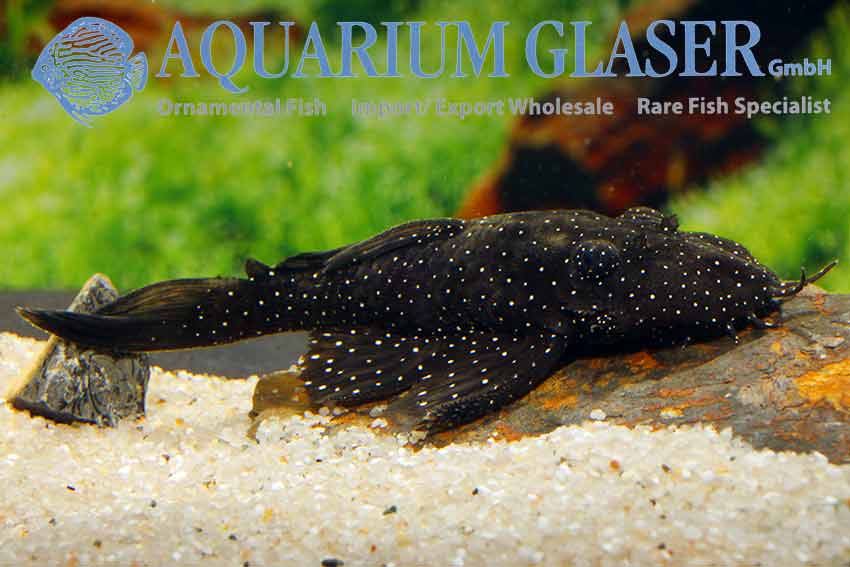
For our customers: the fish have code 26-480-L 181X-1 on our stocklist. Please note that we exclusively supply the wholesale trade.
Text & photos: Frank Schäfer
New Corydoras from Peru


Corydoras sp. C91, male Corydoras sp. C91, female
The pretty Corydoras sp. C91 is already a well known aquarium fish, although it is available only occasionally and very rarely. This species is a typical shortnose or roundnose Cory, which can be kept in the very same way as the common species Corydoras julii or C. trilineatus. The latter represent without any doubt the closest relatives of C91.


Corydoras sp. C91 Longnose, female
Corydoras sp. C91 Longnose, pair
For the first time ever we were able now to import also the long snouted species that has the very same pattern as C91. Sadly we have no information where the fish have been collected. C91 is said to originate from the Rio Huallaga, which is an approx. 1.100 km long tributary of the Maranon, the larger of the two headstreams of the Amazon river. The longsnouted species imitating C91is a very attractive fish, that resembles much to Corydoras leopardus. However, the new species has a much more contrasting pattern in the caudal fin.

Corydoras sp. C115/116, variety with caudal stripe, no shoulder spot

Corydoras sp. C115/116, variety with caudal stripe and shoulder spot

Corydoras sp. C115/116, variety without caudal stripe, but with shoulder spot

Corydoras sp. C115/116, variety without caudal stripe and shoulder spot
From the Rio Madre de Dios originates the saddle noses species C115/116. The Madre de Dios is also about 1.100 km long and is the largest tributary of the Rio Madeira. The Madre de Dios flows between the countries Bolivia and Peru. C115/116 also resembles much in C91, at least some specimens. For C115/116 has a very variable coloration, which is the reason that initially it was thought that it represents two different species. However, breeding the fish showed clearly that it is only one variable species (please see also http://www.aquariumglaser.de/en/corydoras-sp-c-115116_de_1043.html). Now we received for the first time ever very nice wild collected specimens that show the complete number of varieties: animals with and without lateral stripe and animals with or without a shoulder spot.
Keeping all these new Corydoras is easy, but one should keep in mind that only C91 and the long snouted species are schooling fish in the closer sense, while the saddle nosed types rather prefer to live individually or in small groups.
For our customers: C91 has code number 229593, C91 “Longnose” has code 229603, and C115/116 has code 225304 on our stocklist. Please note that we exclusively supply the wholesale trade.
Lexicon: Corydoras: from ancient Greek, means „with helmet and spear“. This refers to the strong armor and fin spines.
Text & photos: Frank Schäfer
Dwarf Armoured Catfish from Paraguay arrived!

We received beautiful, adult Dwarf Armoured Catfish (Lepthoplosternum pectorale). The current size of the fish is 4-6 cm. Wild collected specimens are only very occasionally traded.
For our customers: the fish have code 259202 on our stocklist. Please note that we exclusively supply the wholesale trade.
Text & photo: Frank Schäfer
Rare species of Corydoras available again!
Corydoras sp. Neon Goldstripe wild CW 10 from Peru and Corydoras eques from Brazil are finally available again!

Corydoras sp. CW10

Corydoras eques
Photos: Frank Schäfer
- « Previous Page
- 1
- …
- 4
- 5
- 6
- 7
- 8
- Next Page »





